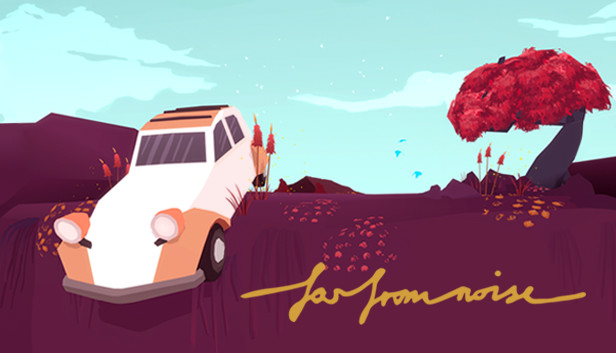Poetry of Transience and Nature: "Far from Noise"
appreciating the poetry of transience
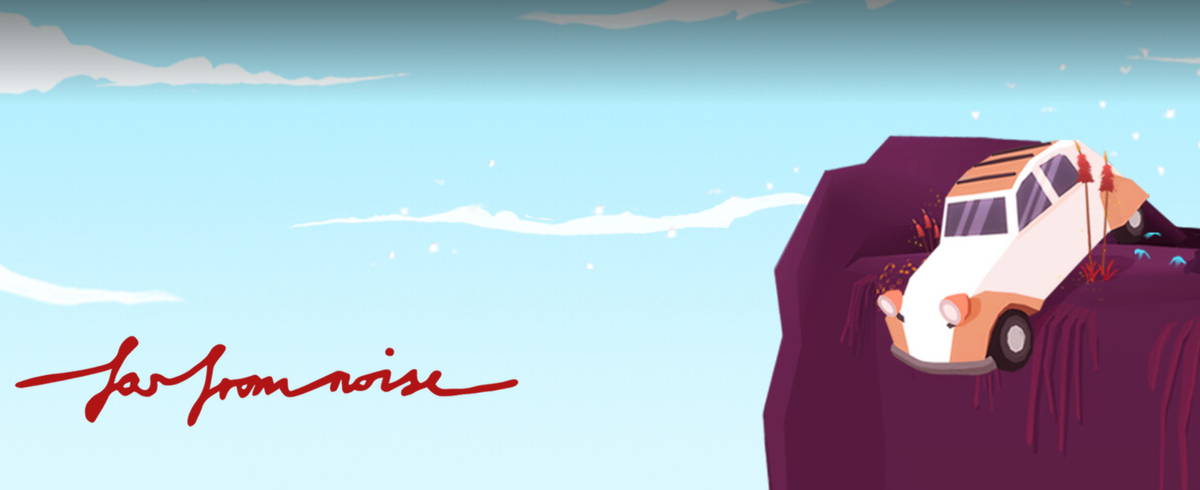
Hey! I'm working on my first post that's part of a series and it's taking a hot second. This post is from my backup vault.
Sometimes, you're down to fight your way through the realm with nothing but a sword and the phenomenal cosmic powers of a good spellbook. And sometimes, you just want to get away from it all. Go somewhere quiet. Far from Noise, if you will. George Batchelor's 2017 game combines calming and meditative techniques with an understated narrative that is equal parts melancholy and cozy. Melan-cozy, if you will.
I replay Far from Noise about once a year. I try to pick an evening where I have the house to myself for a few hours, so I can really sit with it. This is a game that asks you to slow down, take your time, and be in company with your thoughts. Take a breath and consider what you're doing, what you want to say. It's one of the only games I return to so regularly, and I'm pretty sure I've gotten a different one of its multiple endings every time. The experience is refreshing and cathartic every time.
Content warnings
Here's what you can expect content-wise from Far from Noise.
Far from Noise deals with heavy themes of mental health struggle. Depending on player choices, this may include academic burnout, general family struggles, and existential dread.
An additional note: This game can be completed in under two hours. As it is not a mystery narrative, I've decided to make this article a SPOILERS OFF post. If you're looking for the shorthand "is the game good" recommendation, the answer is yes.
Narrative hardware
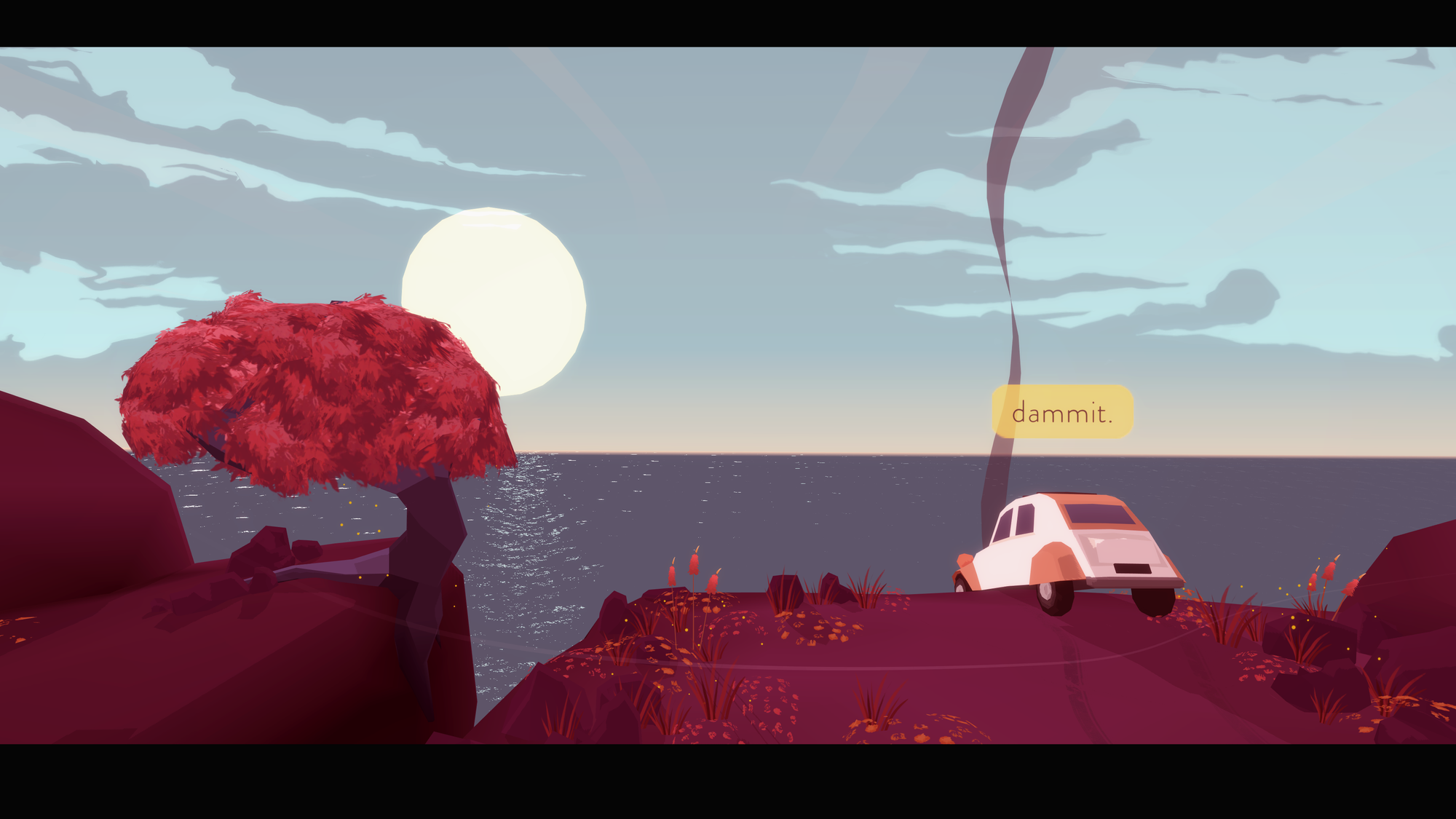
Setting: You are screwed
Picture this: You're in a car. The car is hanging over a cliff. The car will not start.
This is all the setup Far from Noise gives you right out of the box, and that's all it needs. The situation is clear: things are dire, but there's also very, very little you can do about it. The unnamed protagonist can try to start the car and reverse out of here, but the engine is fried. The protagonist's past experience suggests that the engine needs to cool down overnight. Rather a long time to hang by a thread.
The world around you appears quite normal. There's a beautiful (yet threatening) ocean in front of you. A tree clings to the defile on the other side of the cliff. The odd forest critter peeks out from time to time.
You're stuck. All you can do is wait. And talk to yourself.
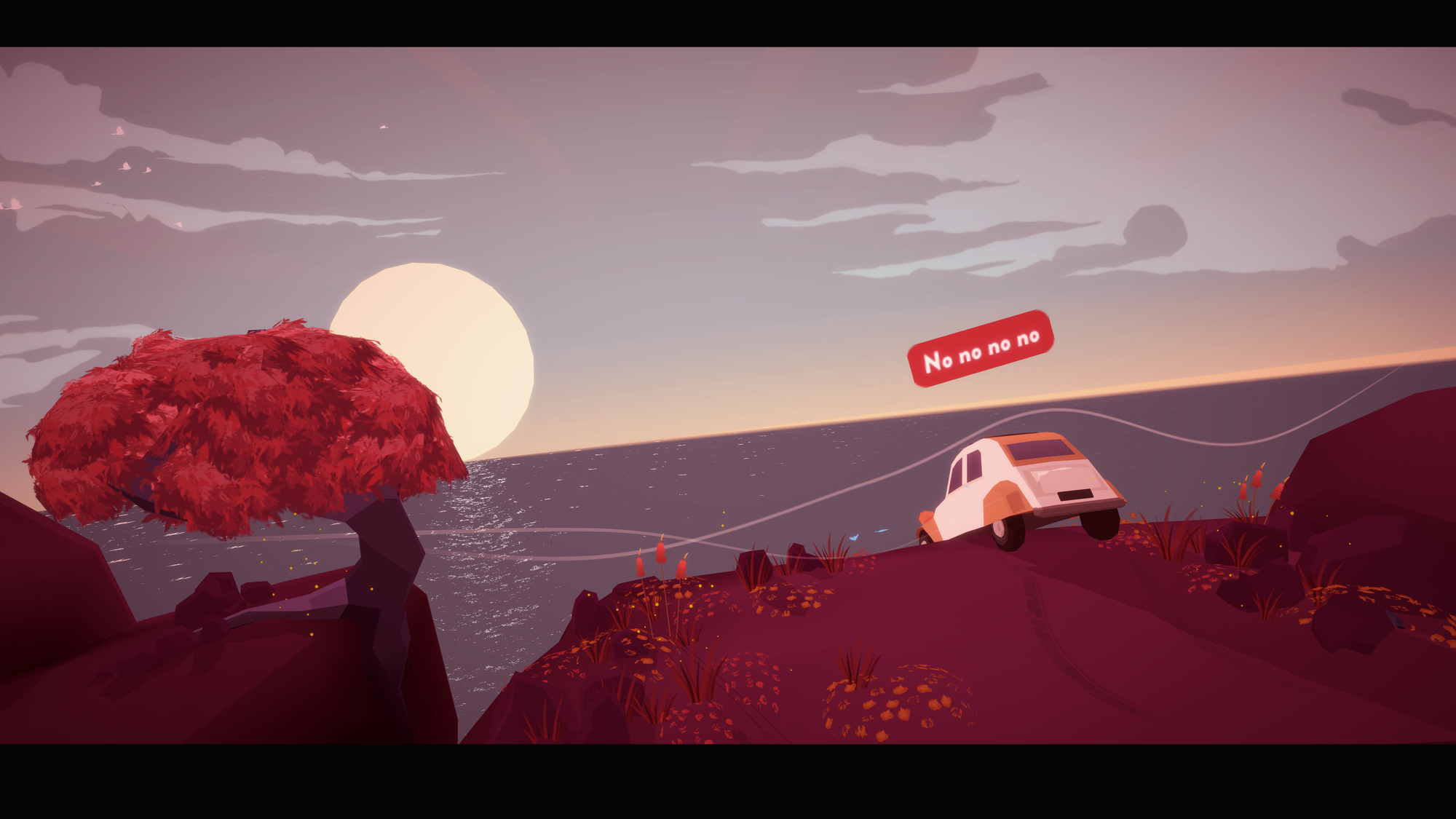
Progression: Choices are all you have
The game is played exclusively through dialogue options, but despite how that makes it sound, Far from Noise is not what I would call a visual novel. Some choices are purely for flavor—deciding whether to apologize for scaring the birds or just continuing to yell for help, for example. Others shape the protagonist's character and backstory.
Yellow text bubbles pop up as the protagonist speaks or takes an action. You're fully in charge of the speed of the conversation, as she'll never move on without you. More stressful or impactful choice points are indicated with pink or blue bubbles, offering you the choice to shape the protagonist's world. Did she name her car? Should she try to get out of the car?
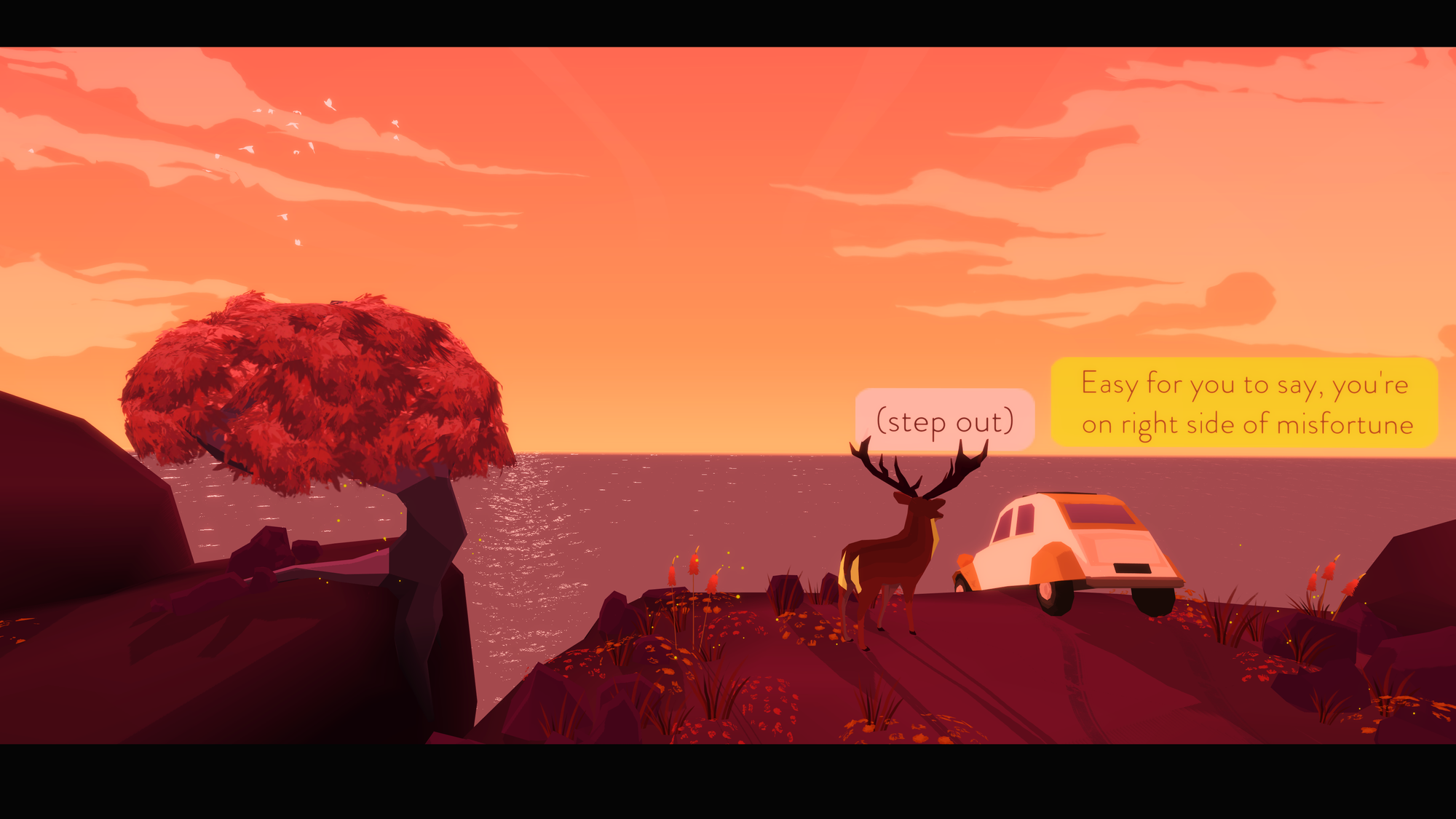
The bulk of the early game consists of the protagonist talking to herself or to her surroundings, trying to keep calm in the midst of a harrowing ordeal. Later conversations bring forward a new conversation partner: the Stag, who offers the protagonist equal parts guidance and companionship as she hangs on through the night.
The Stag's lines do not wait for you to progress them, leaving you solely to react at your own speed to what he says. Moreover, his lines show up not in speech bubbles, but in white subtitles in the letterboxing at the bottom of the screen. I really dig this choice: instead of making the Stag's dialogue a part of the world, it seems to take place outside of the game's world. It gives the Stag an otherworldly quality that continues to blur the line of whether or not what the protagonist hears and experiences is truly real.
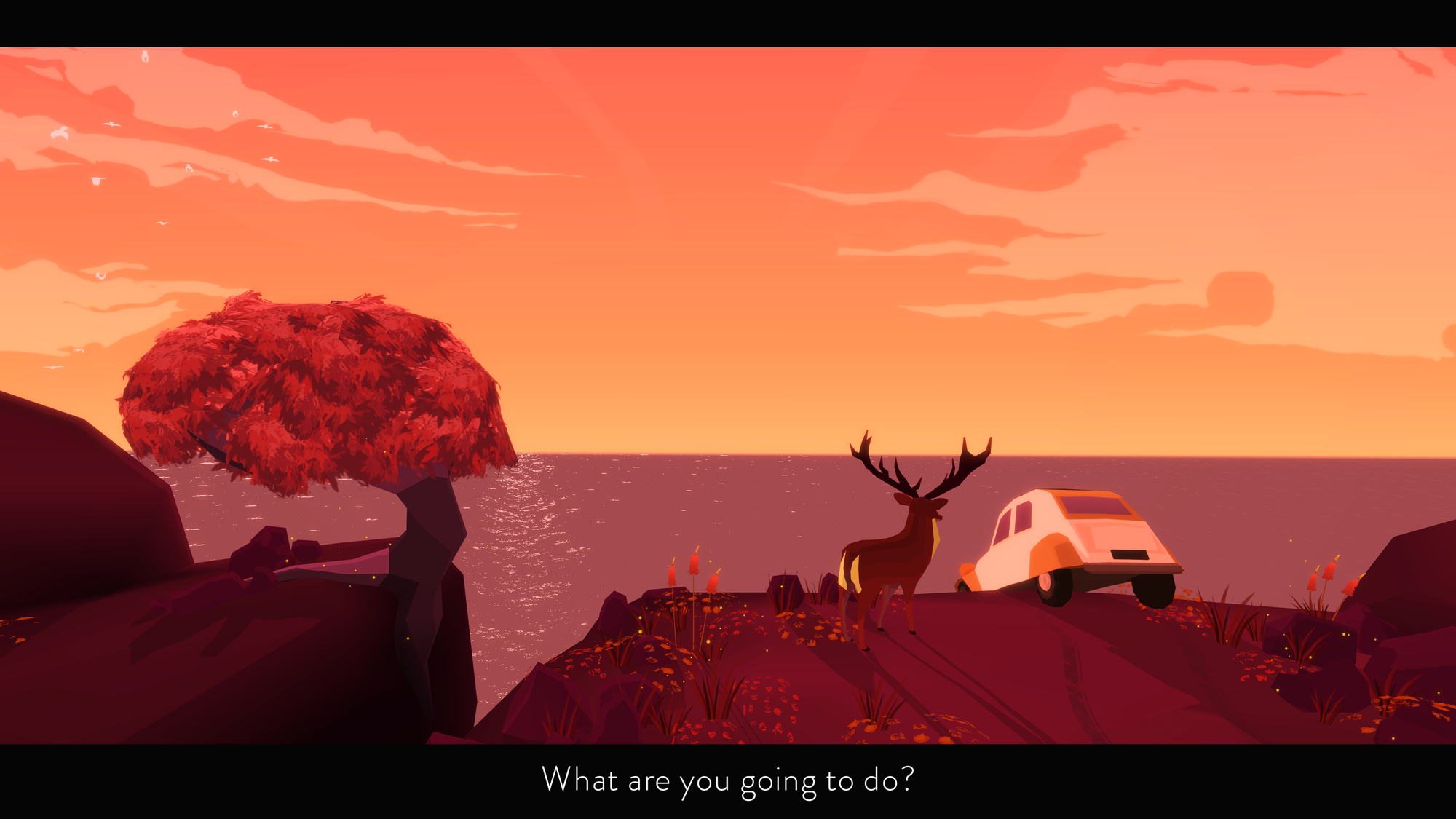
The protagonist's material situation really doesn't change much, no matter the player's choices. You can proactively try the engine and throw the car in reverse, even try to step out of the car entirely, but the situation is simply too dangerous. You can also choose to stubbornly try nothing to remedy the problem.
As the game progresses, the sun sinks lower and lower. It's such a slow change that it takes a minute to register that time has visibly passed. The evening turns to night, and the stars come out. The protagonist has no shortage of beautiful nature to observe while caught in her current predicament. Whether or not she finds it truly calming is maybe up for debate.
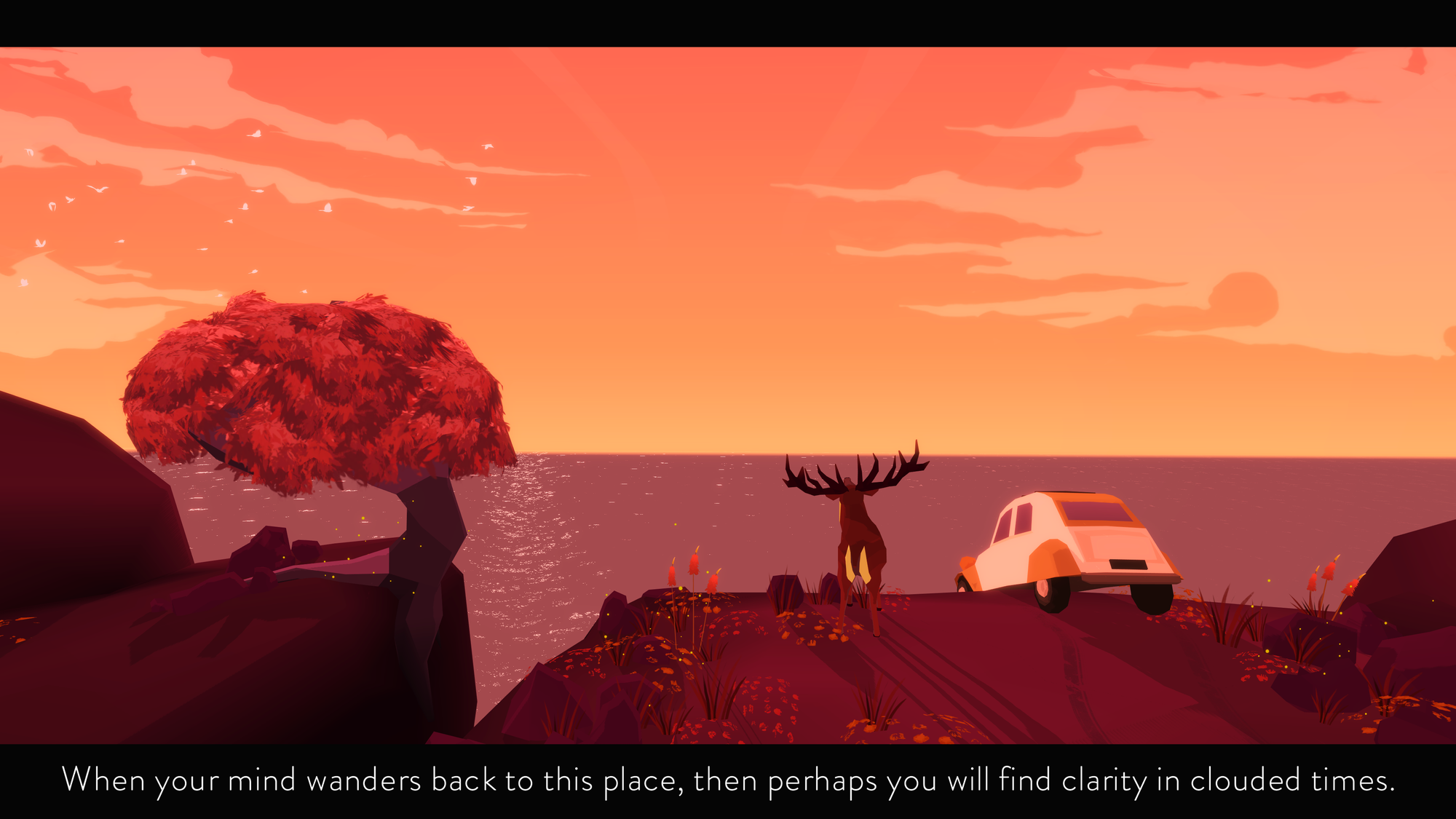
Vibe
I feel the need to stress that I truly don't think of Far from Noise as a scary or stressful game. Even with the rather dire premise that immediately presents itself upon starting the game, the overarching vibe of the game is calm. Gameplay allows you to slowly shape the protagonist's worldview and past, one choice at a time, which makes an emotionally intense, but never fully harrowing experience.
Gameplay
Sounds of nature
The sound design of this game is truly gorgeous and best experienced with headphones or another surround sound/immersive setup. The nature sounds are wonderful and truly add another layer to the experience. You can hear the surf down below, the birds flying past, the breeze blowing past your precariously perched vehicle. The ambiance puts one in mind of a much calmer, less stressful situation.
There are a choice few moments of music that accentuate the moment. No scare chords here, but a thoughtful, intense string burst accompanies a sudden windstorm that threatens to push the car over. A twinkly, ethereal tune heralds the first arrival of the Stag. This understated sound design remains understated in the face of the protagonist's predicament, allowing room for the likes of windstorms and lightning strikes to punch all the harder.
Check out this cliff
The cool sound design helps bring variety to what might otherwise be a bit boring: There's only one screen, really. No matter the time of day, the protagonist is stuck in her car, and outside of a precious few visualizations, you never see beyond this. You're just as stuck as she is, and you have the same tools, too. Not in terms of hardware or engineering, but in terms of mastering your mind and keeping calm in face of death.
The Stag occasionally guides the protagonist through calming exercises that invite her (and the player) to think beyond the confines of the current situation, which provide some of the only variety of perspective in the game.
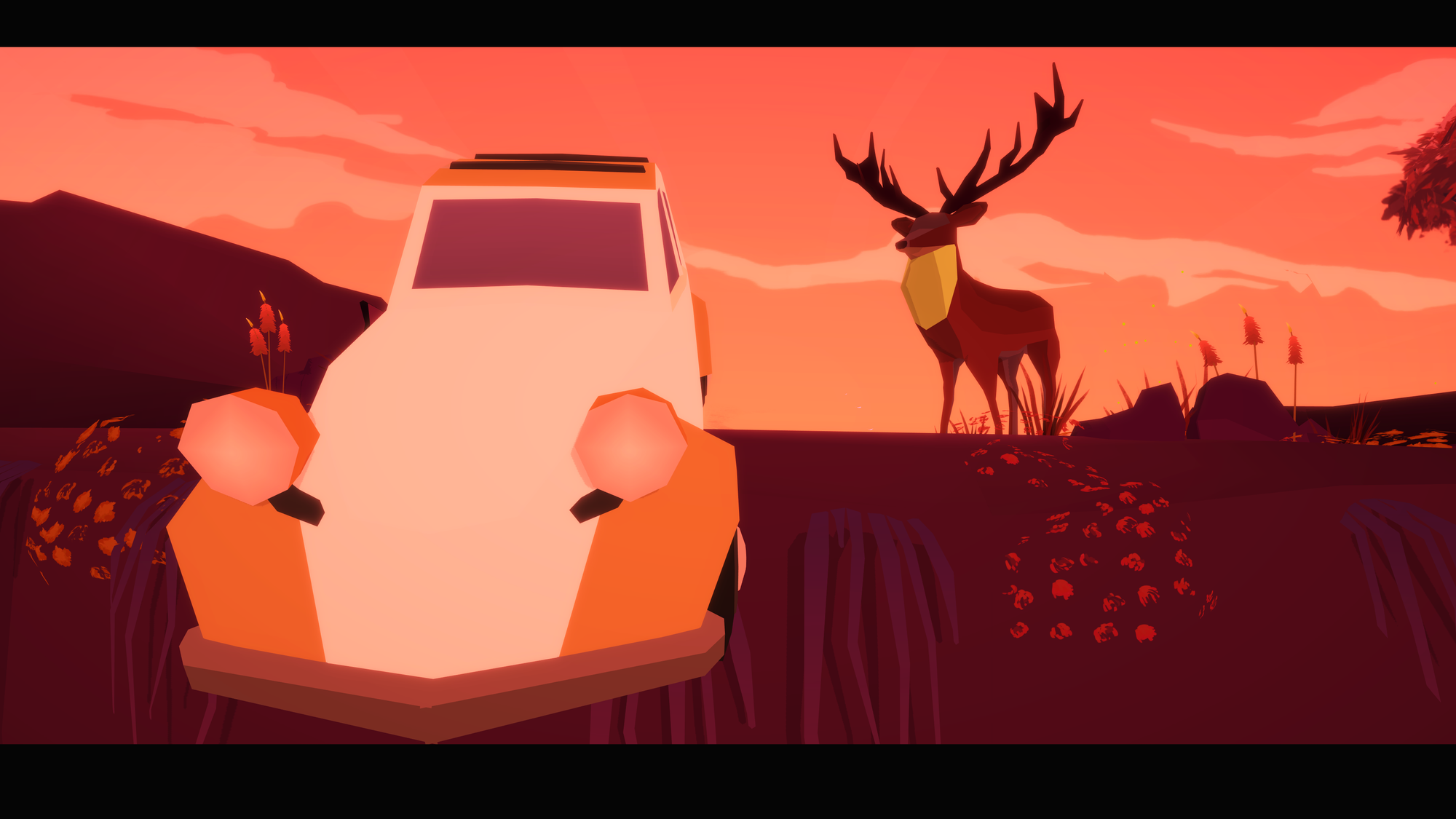
The game's emphasis on philosophy and mental calm shine in moments like these. Dialogue floats away as the letterboxing closes in to mimic the protagonist closing her eyes to breathe. The car appears to fly toward the horizon as she focuses on that distant line. Given nothing else to do but wait, she tries each exercise the Stag offers and brings the player along for the ride.
Far from Noise is a slow game. There are pauses between lines of dialogue and choices. The Stag will sometimes just stand in the quiet for a beat before offering his opinion or another suggestion. The soft passage of time is one of my favorite things about this game. It's one of the most successful mimics of coping with existential fear I've ever seen.
Far from Noise makes no secret of its existentialist leanings, either. In my most recent playthrough, my protagonist dropped out of university after failing to feel purpose and meaning in her dream major. It's a familiar chord for anyone who's struggled academically and/or burned out of a lifelong fantasy. What does it mean, if it all means nothing?
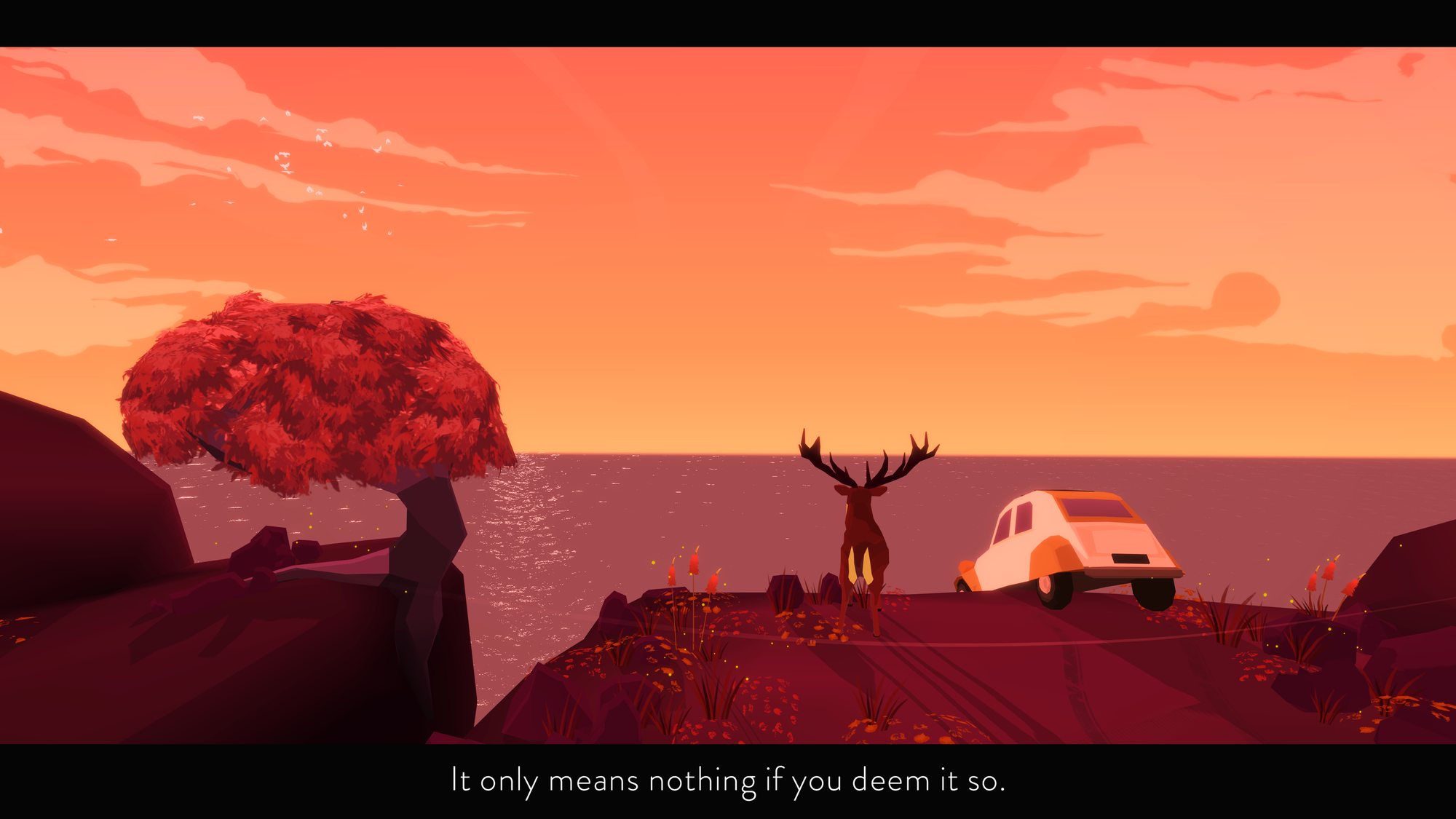
Per the Stag, maybe it really doesn't mean anything. But that doesn't mean it doesn't matter.
Narrative software
Aboutness: Nothing means anything, and that's freeing
There's surely ground to be trodden in what the car and the Stag might represent thematically. The protagonist's situation mirrors a real mental health crisis: whether of her own volition or due to circumstances out of her control, she's hanging on by a figurative thread, literalized as a car about to topple off a cliff, leaving her to work out how best to handle this. The Stag's gentle coaching feels a bit like crisis counseling: offering the protagonist a non-judgmental sounding board and suggesting options she may or may not have considered.
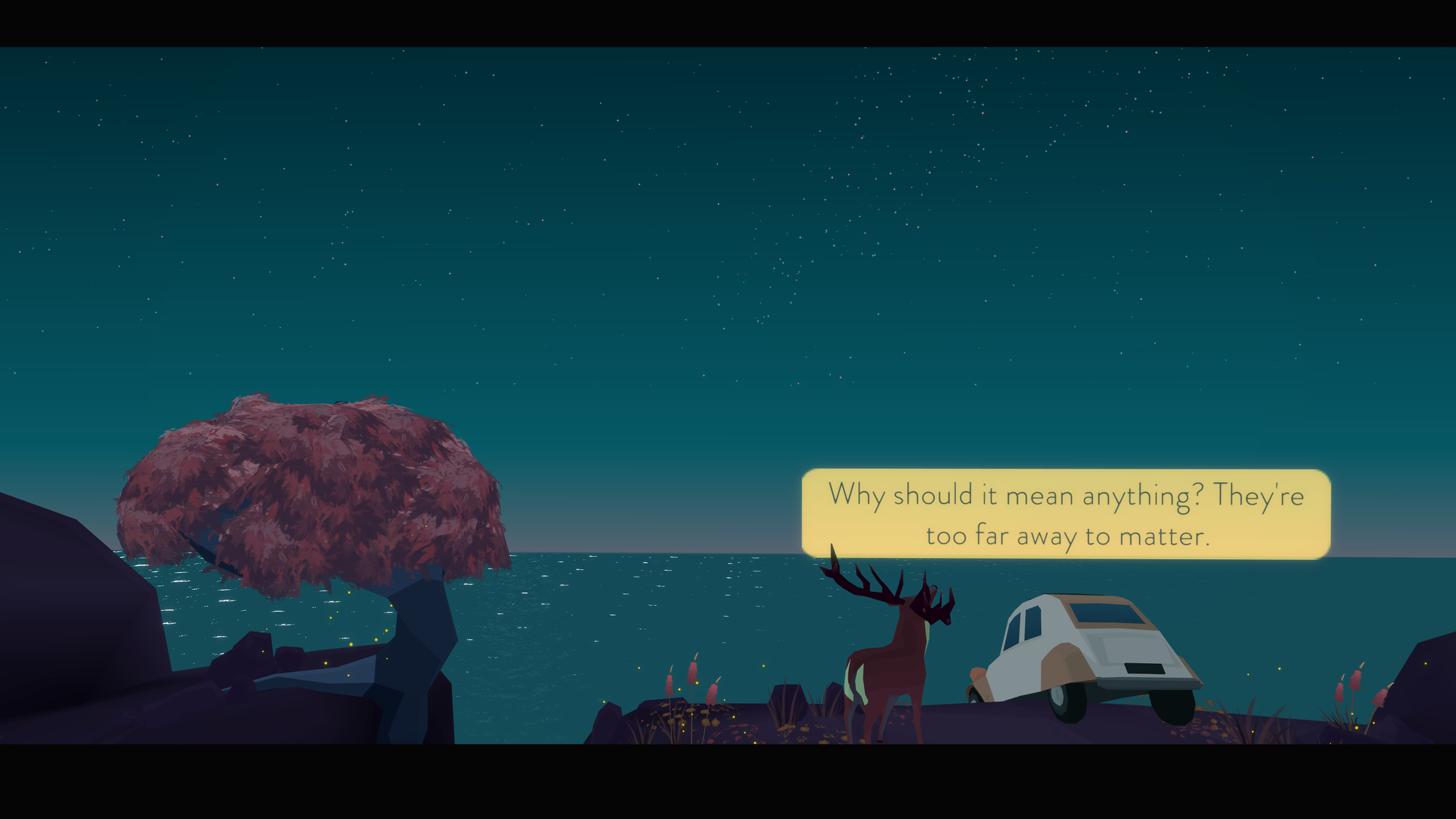
No matter what options you choose, though, you can never have the protagonist remain totally cool and calm. You can't play her like a temporarily indisposed action heroine just waiting for the right moment to spring out of danger, totally unharmed. No, this is always The Worst Thing To Ever Happen, and the point of the game is to live through it with her.
For what it's worth, it IS possible to make the Stag go away. If you're so stubborn as to refuse all help or suggestions, he will leave you alone. But I find the experience much richer when you engage with the game on its level and listen with an open heart: give the Stag's suggestions some thought, and decide how to respond to the challenges the landscape throws at you.
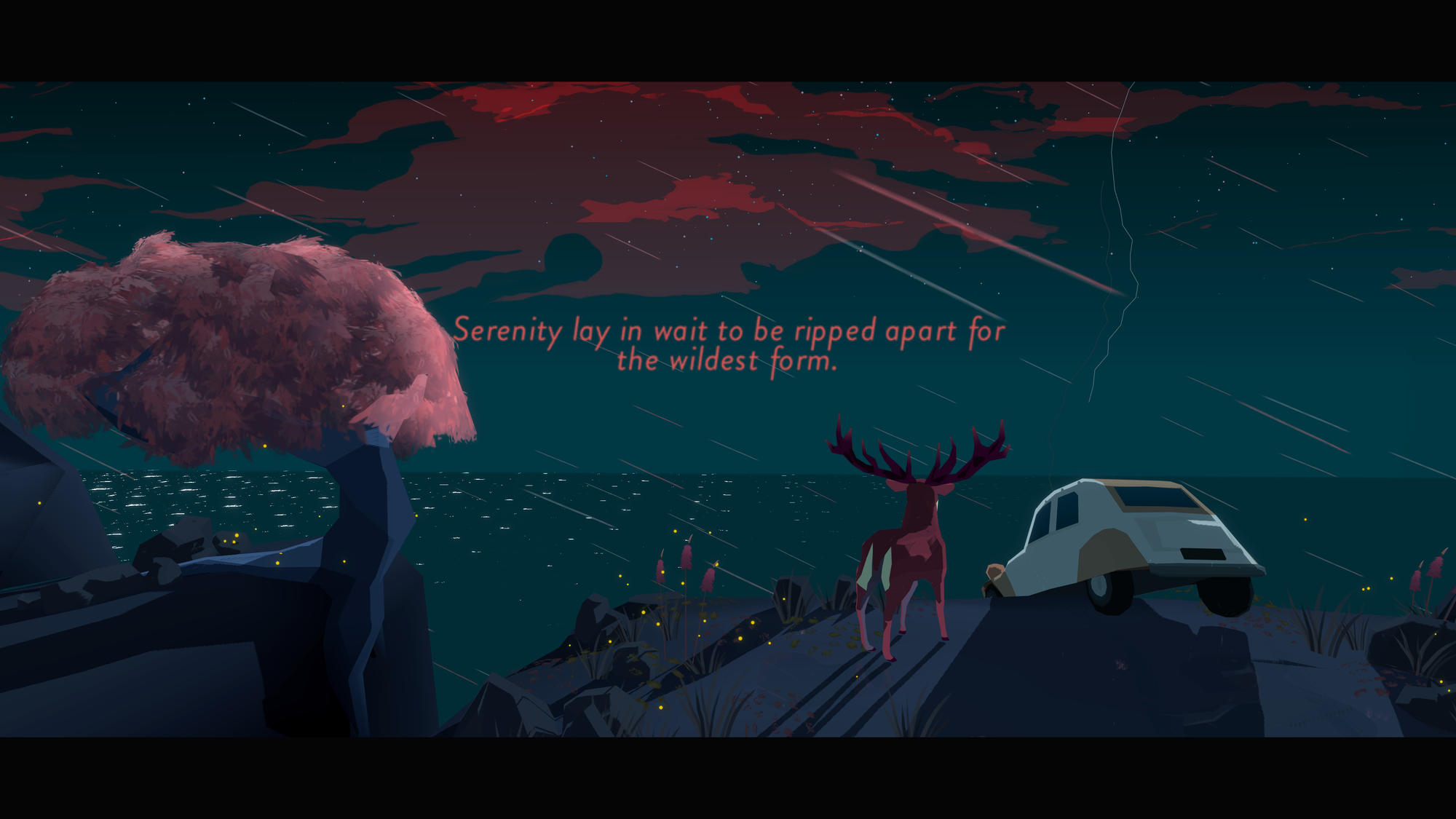
I return to Far from Noise not because I enjoy the stress of being dangled over a cliff, but because I bring something new from my own life every time I do. Coming back to this game feels like meeting with an old friend/therapist. I look forward to seeing the Stag as much as I dread it: the game's themes are sure to dig up some of my old wounds, but I also know that I'll be better for it.
Is Far from Noise a replacement for therapy? Of course not, but I find it to be a net cathartic experience, packaged within a mostly calm environment. Once you make your peace with the fact that you will never see the protagonist get out of the car, a peculiar comfort starts to take over in subsequent plays. And yet, as dangerous as it is, you still root for her to find the strength of will to get out and retake control of her life.
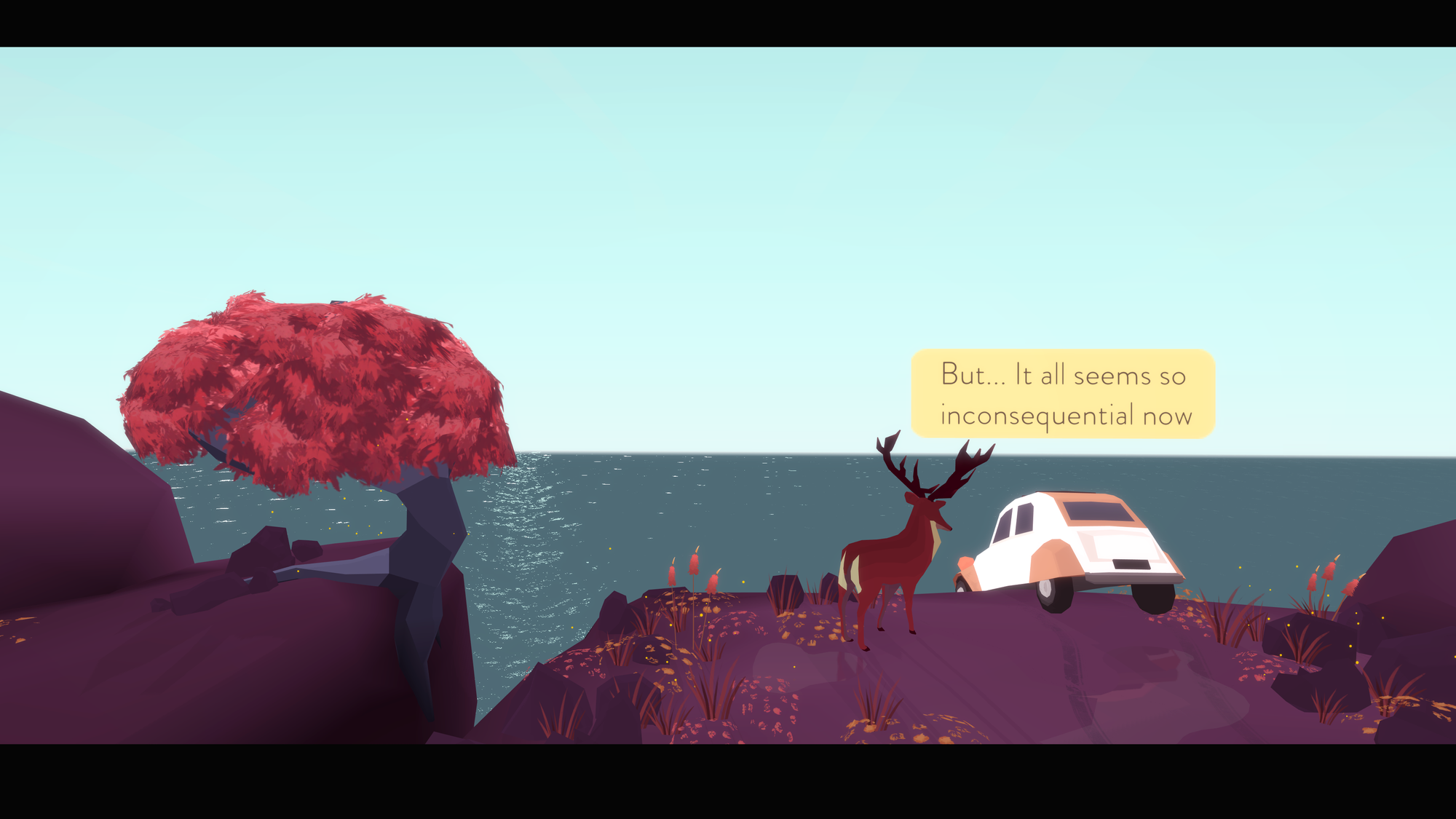
Game taxonomy breakdowns
Star points
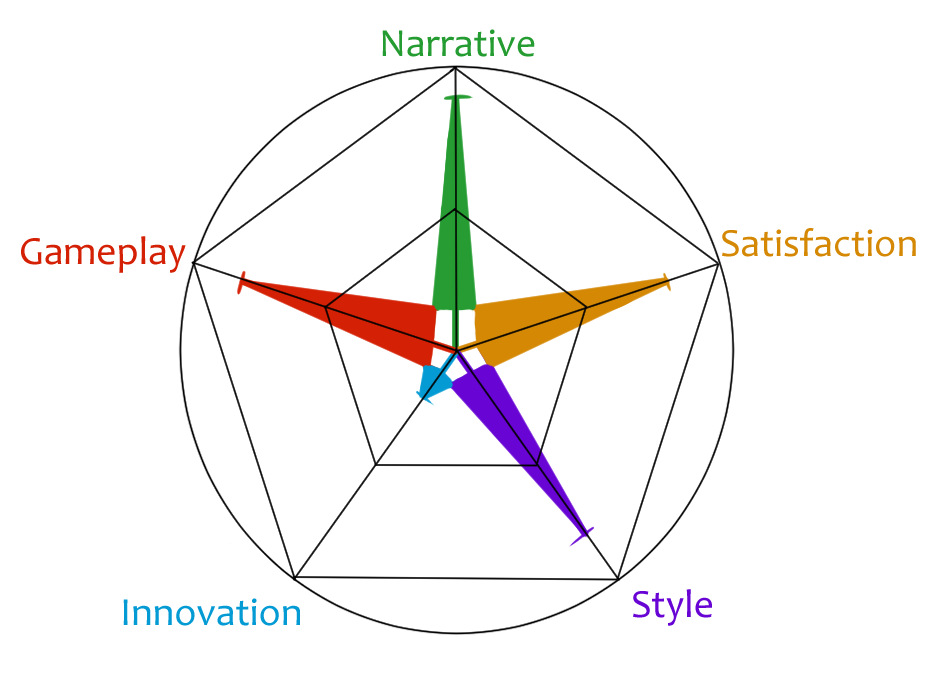
Narrative: 9/10. The melan-cozy vibes hit me just right and make for a slow, meditative experience of diving into the fraught story of a woman who is literally on the edge. It's sure to resonate with anyone who's ever struggled with emotional lows to the tune of depression, anxiety, and burnout. That said, it's a very short experience that leaves a lot open-ended—up to you whether that's a bad thing.
Gameplay: 8/10. There's really, truly nothing you can do in this game besides talk and wait. The choices you can make, though, are tremendously impactful. Driving the conversation can entail treading the waters of a perilous situation, or trawling deep emotional depths. However you choose to keep your head above water, Far from Noise will go with you.
Innovation: 2/10. The shifts in the narrative, like the shifts in the landscape, are subtle but impactful. The game isn't reinventing the genre of narrative-heavy dialogue branches, preferring instead to work with a strong foundation to make a fantastic choice-based game that remains relatively linear.
Style: 8/10. The game's lineless, polygonal figures are rendered in warm and comforting colors, making the whole game read "cozy." Even when things get scary—windstorms, thunder and lightning—Far from Noise has a unified aesthetic that works for its genre and subject matter.
Satisfaction: 9/10. Far from Noise knows not to overstay its welcome and leaves you wanting a little more. While you never see the protagonist get out of the car (at least, not in any ending I've encountered), you as the player can decouple from her and draw thoughtful lessons from your conversations with the Stag.
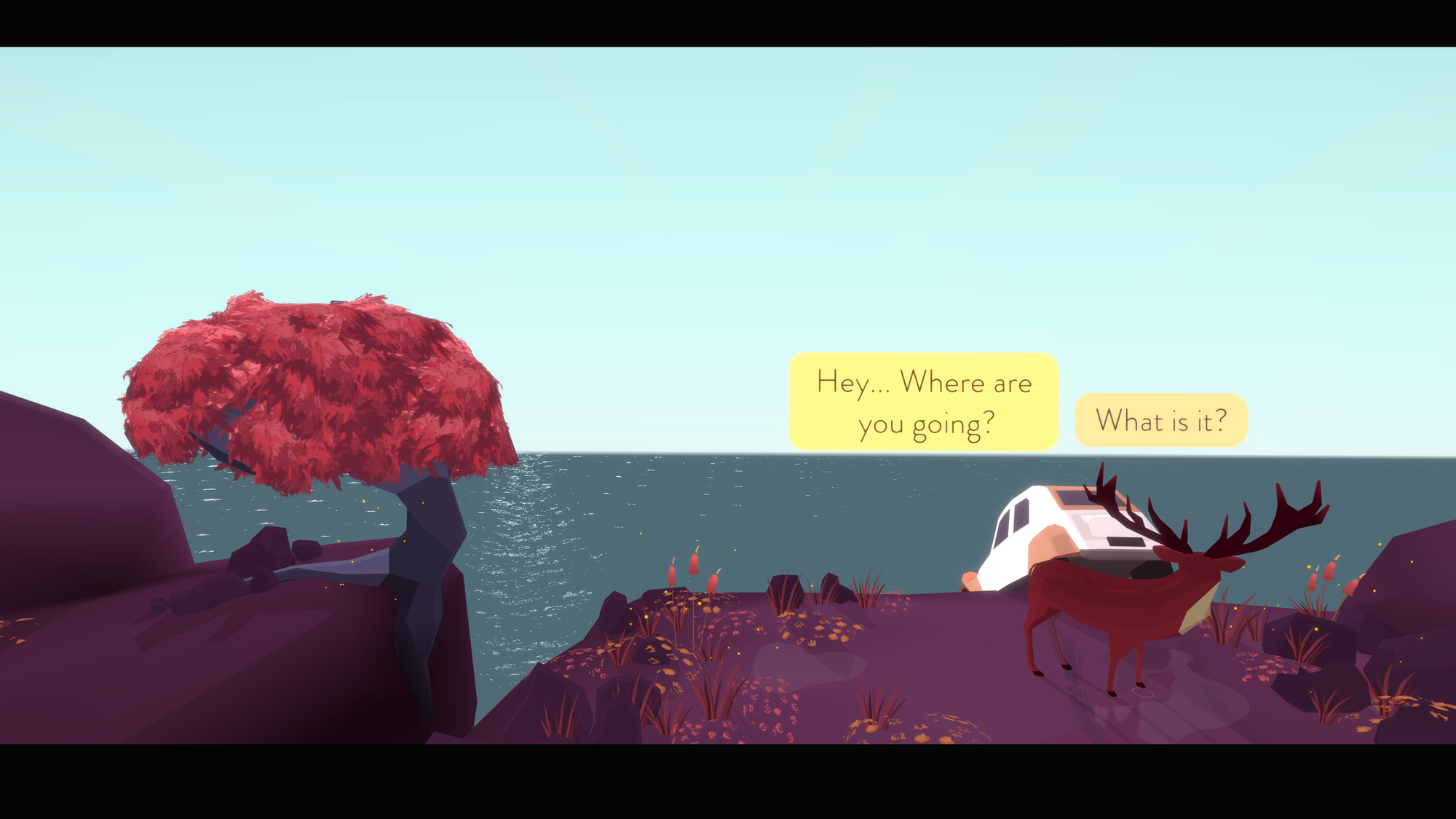
Tetris-Higurashi Rating Scale

I give this game a +8. The game isn't pure story, but it takes clear cues from branching narrative experiences to present a familiar-feeling twist on the kinetic novel. The game is
Flinn's faves: Rapid-fire roundup
Favorite character: The owl. We are all Owl Girl when the owl lands on the car.
Favorite location: The tree on the other side of the cliff. Aspirational. Constant.
Favorite constellation: Zowie the Acrobat.
Favorite moment: Sunrise.
Favorite line: This one right here.
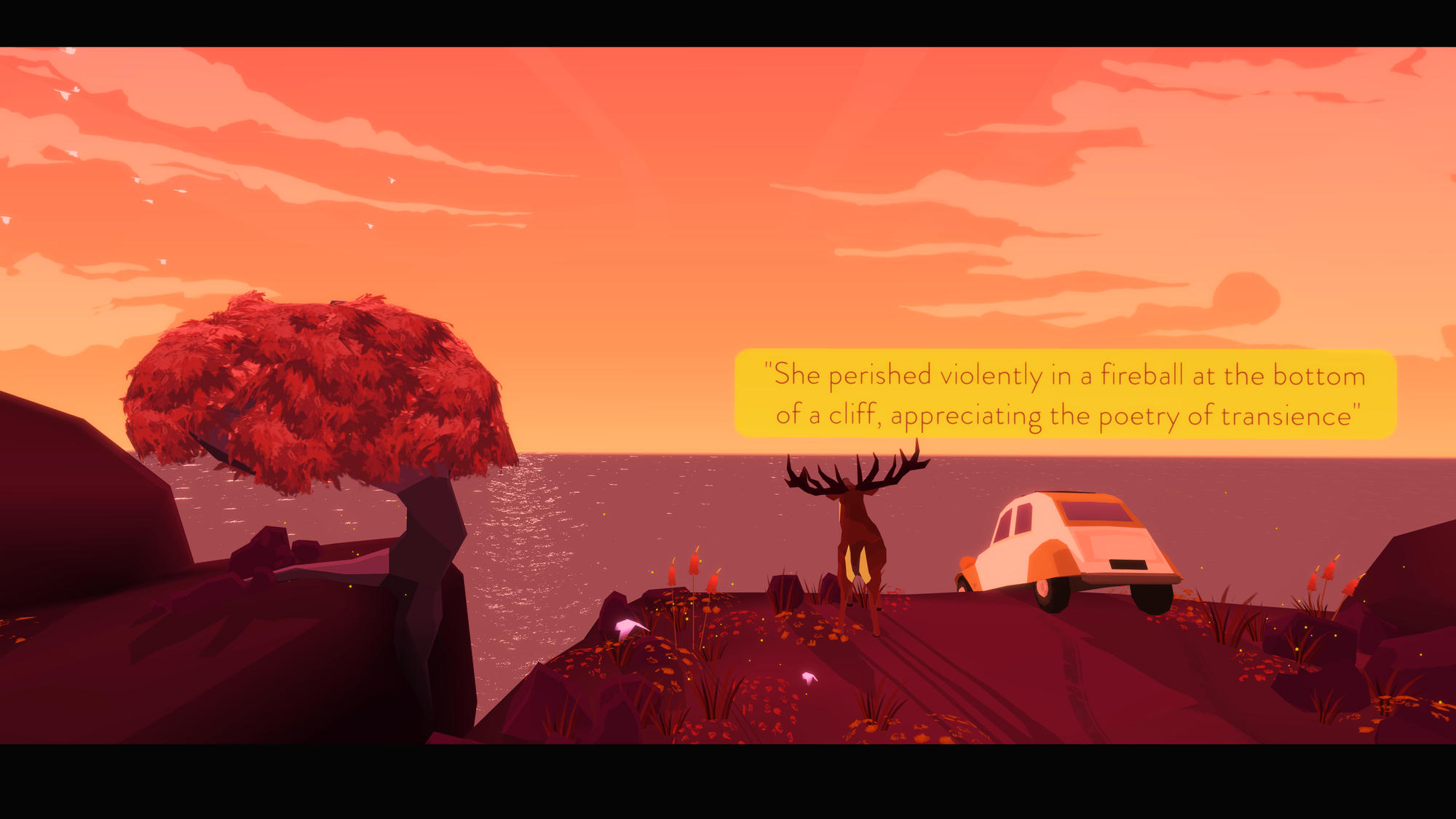
Flinn played Far from Noise on PC via Steam. The game is also available on PlayStation 4.
